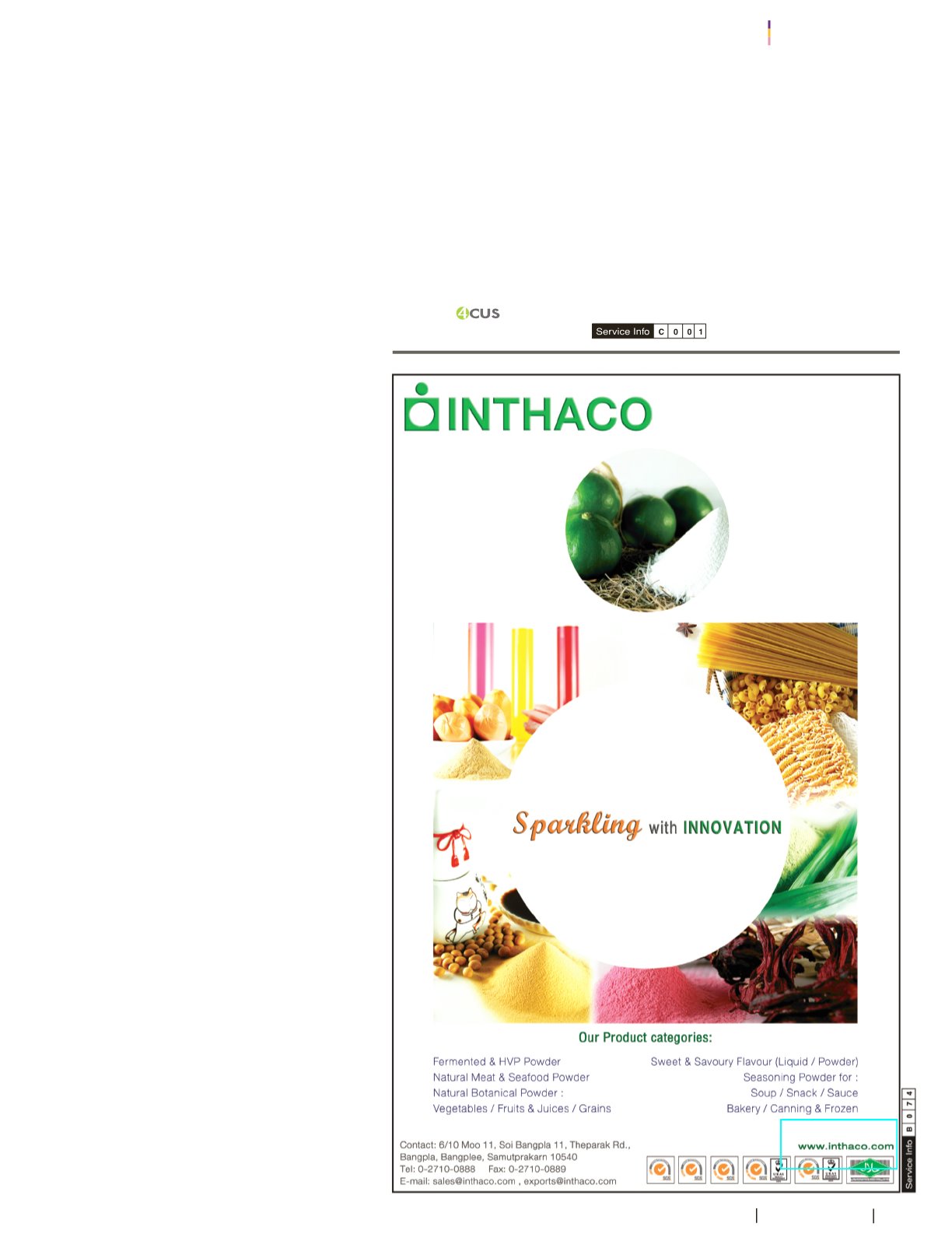
21
DEC 2017 FOOD FOCUSTHAILAND
SURF THE
AEC
totaled 25.26 million tons, valued at THB 768,797
million, moving up by 8.3% and 9.4% respectively,
thanks to the rising global demand, the economic
recovery of Thailand’smain tradingpartners suchas
USA, European Union, Japan and China as well as
the trade upturn of the Middle Eastern and African
countries.
Themainexport products that haveseena rise in
both volume and value are rice, chicken, shrimps,
seasonings,coconutproductsand ready-to-eat foods.
Sugar is the export product that has experienced a
downturn in volume but an increment in valuedue to
the world’s sugar prices that have remained on the
high side in the first half of the year. The same goes
for canned tunaasmanufacturers increasedprices to
reflect thecosts that have jumpedupbyalmost 100%
from last year. Meanwhile, the volume of pineapple
products (canned pineapple and juice) has been on
the risedue to theconstantly increasingdemand from
overseas countries as the prices hurtle down as a
response to the lowercostsofpineapple rawmaterials.
Only2mainproductshaveexperiencedadecline
inbothquantityandvalue;nativestarchand fruit juices
(pineapple juicenot included).Thenativestarchexport
to one of Thailand’s main partners, China, faced an
intense competition with Vietnamese exporters who
tookadvantageofproduct logistics through itsborders
withChina,exempting themselves from13%VATwhile
Indonesia, Thailand’s secondmost important export
market, made less purchases fromThailand as they
turned to rely more on the increased production of
domestic tapioca. Theexport of fruit juiceswent for a
downturnasmanufacturerswereobliged to implement
system improvements forcoconutwatermanufacturing
processes as a response to the new standards
established by European Fruit Juice Association
(AIJN), thus resulting inshort-term reducedproduction
capacity, which is expected to return tonormal in the
endof 2017 or the beginningof 2018.
“Thai food export in the first 9 months of 2017
enjoyed a steep growth in, for example, the Middle
East (+25.2%),China (+22.2%),CLMV (+19.9%)and
Africa (+17.1%).Thecountries that imported less from
Thailand are the original ASEAN countries (-10.7%),
USA (-2.3%) and the UK (-10.9%). CLMV countries
arestillThailand’snumberone tradingpartners, taking
up 16.6% of the market share, followed by Japan
(13.5%), theoriginalASEAN countries (11.6%), USA
(10.6%),Africa (9.3%), China (9.0%), EU (6.0%), the
MiddleEast (4.2%), Oceania (3.3%), UK (3.0%) and
SouthAsia (1.6%)”
Mr.Yongvutadded that theoverallThai foodexport
in2017 isprojected toattainTHB1.03 trillion,withan
8.4% increase. In the last quarter of 2017, the sector
is predicted to continue to benefit from various
supporting factorssuchas thegrowingworldeconomy,
the lower production costs and the increase of
domestic agricultural products. Additionally, chicken
export will alsobenefit from theoutbreakof bird flu in
East Asia and the growing concerns over the safety
of meat imported fromBrazil. Rising demand in food
products during the end-of-year holidays will
continuously help boost Thai food export industry in
the last quarter aswell.
Concerning theupcoming2018 trends, Thai food
industry is set togrowby 8.7%, amountingTHB1.12
trillion,with important tradingpartnerssuchasASEAN
countries that should account for 30% of the whole
export value, Japan (14%), USA (10%), China and
Africa (9% each). The important contributing factors
are (1) theworld’seconomy that isexpected to improve
by3.7% from3.6% in2017as recently forecastby the
IMF, (2) the risingsupplyofThaiagriculturalproductssuchas rice,sugarcane,pineapple,
shrimpsandchicken thanks toproperweatherconditions incontrast to the lowerquantity
of tapioca products and feed corn, (3) the falling food production costs stemming from
thedecreasedpricesof animal feedssuchascorn, soybeanmeal andfishmeal,which
will positively influence Thai livestock sector, (4) the prices of Thailand’s main food
exports such as rice, chicken and shrimps, that are expected to spiral upward in the
global market and (5) theenergy costs that remainon the lower side, thus contributing
positively to the costs of foodmanufacturing industry and logistics.
Thailand’sexported food ispredicted tochange in termsof typeas theproducts tend
to leanmore on the ready-to-eat products. In 1998, ready-to-eat foods only accounted
for35%of the total foodexportwhile the remaining65%were fresh foods, rawmaterials
and primary processed foods. In 2016, however, the percentage of the exported
ready-to-eat products jumpedup to50%, equaling that of fresh foods, rawmaterialsand
primary processed food. In the past 20 years, the annual growth rate of ready-to-eat
productshasgoneupby7.3%while that of theother typesof foodonlyenjoyeda5.0%
increase.


